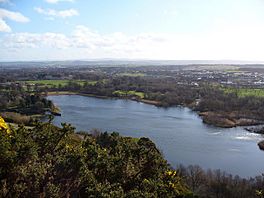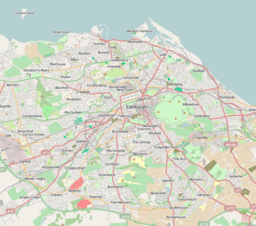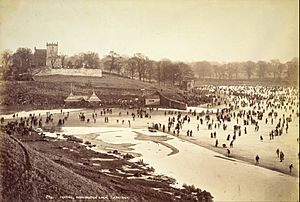Duddingston Loch facts for kids
Quick facts for kids Duddingston Loch |
|
|---|---|

View of the loch
|
|
| Location | Edinburgh |
| Coordinates | 55°56′N 3°09′W / 55.94°N 3.15°W |
| Type | Freshwater pond |
| Primary outflows | Braid Burn |
| Catchment area | Arthur's Seat |
| Basin countries | Scotland |
| Max. length | 555 metres (1,821 ft) |
| Max. width | 285 metres (935 ft) |
| Max. depth | 3 metres (9.8 ft) |
| Islands | several islets |
Duddingston Loch is a beautiful freshwater lake, or "loch," located in Edinburgh, Scotland. It's super special because it's the very last natural loch left within the city! You can find it just south of Holyrood Park and southwest of the small village of Duddingston.
Contents
Where is Duddingston Loch?
Duddingston Loch sits on the southern side of Holyrood Park. It's right below the famous hill called Arthur's Seat. This loch is the only natural one left in Edinburgh. It's also the biggest of the three lochs found inside Holyrood Park. The loch covers an area of about 8 hectares (20 acres). At its deepest point, it goes down about 3 metres (9.8 ft).
A Look Back in Time: History of the Loch
Duddingston Loch has a long and interesting history! About three thousand years ago, during the Bronze Age, some amazing things happened here. A collection of weapons, like swords and spears, and other cool items were broken on purpose. Then, they were carefully placed into the waters of Duddingston Loch.
These ancient treasures stayed hidden at the bottom of the loch for a very long time. In 1778, a special machine called a dredger pulled them up from the loch bed. Today, you can see the "Duddingston Loch hoard" displayed at the National Museum of Scotland. It's in their Early People gallery.
Duddingston Loch is also famous because of a painting! The well-known artist Henry Raeburn painted his famous picture, The Skating Minister, right here. The loch used to be a very popular spot for skaters. The Edinburgh Skating Club even met there to skate. But now, it rarely gets cold enough for the ice to be thick enough for skating. The loch was also important in the early days of the sport of Curling.
Fishing at the Loch
If you enjoy fishing, you can do it at Duddingston Loch! Most people come here for coarse fishing. You can get free permits from the Holyrood Park Ranger Service. Remember, you can only fish from the north shore of the loch. Also, any fish you catch must be put back into the water. The main types of fish you might catch are common carp, perch, and roach. There are also some pike living in the loch.
Amazing Wildlife
Duddingston Loch is a fantastic place for nature and animals! It has been a special bird sanctuary since 1925. This means it's a safe home for many different birds. The Scottish Wildlife Trust also has a wildlife reserve called Bawsinch on the southern side of the loch. This reserve covers about 26 hectares (64 acres).
Besides the open water, the loch area has bushes, trees, and a huge bed of common reed plants. These reeds are called Phragmites australis. It's the biggest area of these reeds in the Lothians region! You might also spot some cool mammals around Duddingston Loch. These include otters, hedgehogs, and water voles.
The loch is especially famous for its many birds. The western end of the loch is home to the largest heronry in the Lothians. A heronry is a place where herons build their nests. In 2017, there were 27 nests there! Other birds that breed here include Canada geese, mute swans, tufted ducks, great crested grebes, sparrowhawks, sedge warblers, and reed buntings. Many other types of wildfowl visit the loch when they are not breeding. Sometimes, even rarer birds like smews, ring-necked ducks, ruddy ducks, and great bitterns have been seen here!



